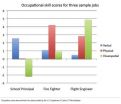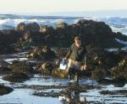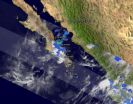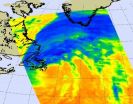Portable laser devices to improve disease diagnosis
2010-09-22
(Press-News.org) Portable devices that use a laser beam to probe bones, teeth, and other parts of the body for early signs of diseases like osteoporosis and tooth decay may seem like something out of science fiction. But those devices are moving closer to reality, according to an article in the current issue of Chemical & Engineering News (C&EN), ACS' weekly newsmagazine.
C&EN Senior Editor Celia Henry Arnaud notes that these new diagnostic tools will have the ability to see beneath the skin and detect disease, without exposing patients to X-rays. They embrace a technology that involves focusing a laser beam painlessly through the skin onto a bone or onto the surface of a tooth. After hitting its target, the beam returns to an electronic detector with imprinted information that can reveal whether disease is present. Called Raman spectroscopy, the technology is a mainstay tool in chemistry laboratories that is finding a new life in medicine.
The article describes growing medical interest in Raman-based devices, especially for diagnosing osteoporosis and other bone diseases, and for tracking the effectiveness of treatment. Another application may be in very early detection of tooth decay, so that dentists can treat soft spots on tooth enamel before "drill-and-fill" becomes the only option. The technique could also mean blood tests done without taking blood samples, the article indicates.
INFORMATION:ARTICLE FOR IMMEDIATE RELEASE
"Raman Heads For The Clinic"
This story is available at
http://pubs.acs.org/cen/coverstory/88/8838cover.html
END
ELSE PRESS RELEASES FROM THIS DATE:
2010-09-22
Toronto, Canada – In an international study of patients with a devastating type of dementia that often strikes in middle age, researchers have found intriguing evidence that career choice may influence where the disease takes root in the brain.
The study was led by Baycrest's Rotman Research Institute in collaboration with the Memory and Aging Centre at the University of California, San Francisco and several U.S. and European clinical sites. It appears online today in the Article in Press section of the journal Neuropsychologia, ahead of publication.
Researchers ...
2010-09-22
A study led by St. Jude Children's Research Hospital investigators links the muscle weakness and other symptoms of a rare neurodegenerative disease to a misstep in functioning of a normal protein, rather than its build-up inside cells. The finding offers insight into the mechanism driving common nervous system disorders like Parkinson's and Alzheimer's diseases.
The work advances understanding of how the inherited mistake at the heart of spinobulbar muscular atrophy (SBMA) leads to the death of neurons in the brain and spinal cord. Investigators showed that the underlying ...
2010-09-22
September 22, 2010 -- Most studies of the food choices available near public schools have focused on fast food outlets rather than the full range of options available to schoolchildren. A new study by researchers at Columbia University's Mailman School of Public Health examined the patterns of exposure to a broad range of food outlets for school children in New York City.
The study, "Disparities in the Food Environments of New York City Public Schools," is published in the American Journal of Preventive Medicine Volume 39, Issue 3, and cited as the "Editor's Choice" ...
2010-09-22
Bethesda, Md. (September 22, 2010) – Taking chromium picolinate may help lessen inflammation associated with diabetic nephropathy (kidney disease), say researchers at the Medical College of Georgia in Augusta. In a study comparing diabetic mice treated with chromium picolinate with those that received placebo, the researchers found that mice who received the supplement had lower levels of albuminuria (protein in the urine), an indication of kidney disease.
The Study
To arrive at their conclusions, the researchers compared three groups of mice, one lean, healthy group ...
2010-09-22
(Santa Barbara, Calif.) –– Sometimes, treasures can be found in your own backyard –– especially if you know what to look for. This is what happened to Jeff Goddard, project scientist with the Marine Science Institute at UC Santa Barbara.
Goddard was working in the tide pools at Carpinteria Reef, in Carpinteria State Park, Calif., when he found a new species of nudibranch –– a group of sea slugs noted for their bright colors and delicate forms. Recognizing it as new, Goddard carefully documented the living specimen before preserving it and sending it off to Terrence M. ...
2010-09-22
By following the "nose" of fruit flies, Yale scientists are on the trail of new insect repellents that may reduce the spread of infectious disease and damage to agricultural crops. That's because they've learned for the first time how a group of genes used to differentiate smells is turned on and off, opening new possibilities for insect control. Just as in new drug development, researchers can target these or similar genes in other insects to create substances that make crops and people "invisible" to insect antennae. Without the ability to smell correctly, the insects ...
2010-09-22
The GOES-13 satellite may be stationed in orbit over the eastern U.S., but it has a wide field of view from the eastern Atlantic to the eastern Pacific, and today it captured three tropical cyclones in one image.
At 1445 UTC (10:45 a.m. EDT) today, Sept. 22, the Geostationary Operational Environmental Satellite called GOES-13 captured Tropical Storm Lisa in the far eastern Atlantic, a developing tropical low in the south-central Caribbean Sea, and Tropical Storm Georgette in the eastern Pacific Ocean, making landfall in Baja California. The GOES series of satellites ...
2010-09-22
Hurricane Igor may have transitioned into a post-tropical hurricane late yesterday, but when he approached Newfoundland, Canada and merged with an area of low pressure it resulted in heavy rainfall throughout the region. NASA satellites captured Igor's northern march toward the Labrador Sea yesterday.
NASA's Terra and Aqua satellites captured visible and infrared images of Hurricane Igor yesterday as he brought heavy rainfall into northeastern Canada. A visible image of Hurricane Igor over Newfoundland, Canada was captured by the Moderate Resolution Imaging Spectroradiometer ...
2010-09-22
TORONTO, ON – Aviation history was made when the University of Toronto's human-powered aircraft with flapping wings became the first of its kind to fly continuously.
The "Snowbird" performed its record-breaking flight on August 2 at the Great Lakes Gliding Club in Tottenham, Ont., witnessed by the vice-president (Canada) of the Fédération Aéronautique Internationale (FAI), the world-governing body for air sports and aeronautical world records. The official record claim was filed this month, and the FAI is expected to confirm the ornithopter's world record at its meeting ...
2010-09-22
Better treatments and prevention for typhoid fever may emerge from a laboratory model that has just been developed for the disease. The model is based on transplanting human immune stem cells from umbilical cord blood into mice that are susceptible to infections.
The transplanted cells live alongside the mouse's own immune system. Although mice are normally resistant to the dangerous strain of Salmonella that causes typhoid fever, the bacteria are able to reproduce in the mice that have received transplanted human cells.
Because typhoid fever affects only humans, ...
LAST 30 PRESS RELEASES:
[Press-News.org] Portable laser devices to improve disease diagnosis




